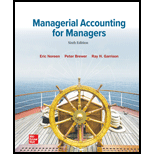
1
Introduction: Cost volume profit analysis (CVP) is used to ascertain the affect on company’s net income and operating income with respect to change in costs and volume of the production of the company. Break-even point is the level of sales which minimum required to overcome fixed and variable cost of the company.
It is the condition of no
To prepare: The cost volume profit graph for the company.
2.
Introduction: Cost volume profit analysis (CVP) is used to ascertain the affect on company’s net income and operating income with respect to change in costs and volume of the production of the company. Break-even point is the level of sales which minimum required to overcome fixed and variable cost of the company.
It is the condition of no profits no loss for the company.
To calculate: The company break-even point in unit sale using cost volume profit analysis.
Want to see the full answer?
Check out a sample textbook solution
Chapter 2 Solutions
Loose Leaf For Managerial Accounting for Managers
- Stanley Woodworks manufactures wooden cabinets and can either make or buy a specific cabinet door component. The cost to manufacture the component is $12 for direct materials, $9 for direct labor, and $11 for variable overhead. Additionally, a supervisor is required to oversee production of the component at an annual salary cost of $60,000. If Stanley Woodworks requires 120,000 components per year, the maximum purchase price per unit they should consider paying is $__.arrow_forwardAnswer? ? Financial accountingarrow_forwardhello tutor please help me answerarrow_forward
- Financial accounting problemarrow_forwardGinx Enterprises had $250,000 in sales on account last year. The beginning accounts receivable balance was $15,000, and the ending accounts receivable balance was $22,000. The company's average collection period (age of receivables) was closest to: (a) 19.54 days. (b) 36.68 days. (c) 27.02 days. (d) 52.45 days. Need answerarrow_forwardHelparrow_forward

 AccountingAccountingISBN:9781337272094Author:WARREN, Carl S., Reeve, James M., Duchac, Jonathan E.Publisher:Cengage Learning,
AccountingAccountingISBN:9781337272094Author:WARREN, Carl S., Reeve, James M., Duchac, Jonathan E.Publisher:Cengage Learning, Accounting Information SystemsAccountingISBN:9781337619202Author:Hall, James A.Publisher:Cengage Learning,
Accounting Information SystemsAccountingISBN:9781337619202Author:Hall, James A.Publisher:Cengage Learning, Horngren's Cost Accounting: A Managerial Emphasis...AccountingISBN:9780134475585Author:Srikant M. Datar, Madhav V. RajanPublisher:PEARSON
Horngren's Cost Accounting: A Managerial Emphasis...AccountingISBN:9780134475585Author:Srikant M. Datar, Madhav V. RajanPublisher:PEARSON Intermediate AccountingAccountingISBN:9781259722660Author:J. David Spiceland, Mark W. Nelson, Wayne M ThomasPublisher:McGraw-Hill Education
Intermediate AccountingAccountingISBN:9781259722660Author:J. David Spiceland, Mark W. Nelson, Wayne M ThomasPublisher:McGraw-Hill Education Financial and Managerial AccountingAccountingISBN:9781259726705Author:John J Wild, Ken W. Shaw, Barbara Chiappetta Fundamental Accounting PrinciplesPublisher:McGraw-Hill Education
Financial and Managerial AccountingAccountingISBN:9781259726705Author:John J Wild, Ken W. Shaw, Barbara Chiappetta Fundamental Accounting PrinciplesPublisher:McGraw-Hill Education





